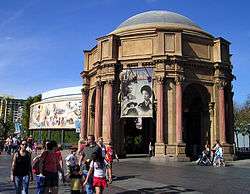Golden Dreams
| Golden Dreams | |
|---|---|
 | |
| Disney California Adventure | |
| Area | Golden State |
| Status | Closed |
| Opening date | February 8, 2001 |
| Closing date | September 7, 2008 |
| Replaced by | The Little Mermaid: Ariel's Undersea Adventure |
| General statistics | |
| Attraction type | Film presentation |
| Duration | 25 minutes |
| Hosted by | Califia (Whoopi Goldberg) |
|
| |
|
| |
|
| |
|
| |
| Golden Dreams | |
|---|---|
| Directed by | Agnieszka Holland |
| Written by | Tom Fitzgerald (Disney Imagineering executive)[1] |
| Starring |
Whoopi Goldberg Yasuko Takahara Richard Balin Eric Matheny Mark Neveldine |
| Narrated by | Whoopi Goldberg |
| Music by | Walter Afanasieff (song) |
| Cinematography | Jack N. Green |
| Edited by | Erica Mireles Folsey and Benjamin Rawls (assistant editors) |
Production company |
Golden Dreams Productions Walt Disney Pictures |
| Distributed by | Disneyland Resort |
Release dates |
|
Running time | 22 |
| Country | United States |
| Language | English |
Golden Dreams was a film about the history of California. It was a featured attraction at Disney California Adventure Park at the Disneyland Resort in Anaheim, California, opening with the park on February 8, 2001. It starred Whoopi Goldberg as Califia, the Queen of California. On September 7, 2008 the last showing of the film to the public was made. The theater was razed in July 2009 and was replaced by The Little Mermaid: Ariel's Undersea Adventure. However, the exterior replica of the Bernard Maybeck's Palace of Fine Arts remained. The final showing took place as a private showing for cast members on March 26, 2009.
Synopsis
Guests entered the theater, a replica of the Bernard Maybeck façade of San Francisco's Palace of Fine Arts, a famed Bay Area landmark constructed for the 1915 Panama-Pacific Exposition.
As the show began, two tall art deco statues of a single goddess-like woman, one on either side of a film projection screen, were bathed in golden light. The statue on the right "comes to life," personified by Goldberg, through a video of her face, which was projected from the rear onto the translucent head of the figure. The statue introduced herself as "Califia, the Queen of California." Califia explains that she is the spirit within California, and an inspiration to many famous Californians. Goldberg appears in some of the filmed sequences that follow as Califia—in disguise—to comment or offer encouraging words to various characters who find themselves in challenging situations.
The 70-mm film highlighted admirable and regrettable eras and incidents in the history of California, including vivid illustrations of injustice. Scenes featuring Chumash Indians living a peaceful life on the shore, for example, are followed by the same Indians being held captive by Spanish missionaries and conquistadors.
After the establishment of California, events such as the troubles endured by Chinese laborers working on the railroad and miners during the Gold Rush of 1849 are presented. The immigration issue faced by Japanese women seeking to live in the United States, especially California, is also shown. Japanese and other Asians were denied entry, although wives of established immigrants were allowed to enter. Many women became "picture brides," agreeing to marriage on the basis of exchanged photographs in order to come to the United States. A powerful dramatization shows the crushed hopes of one young picture bride whose husband is far older than represented in the photo he provided. The film continues into the 20th century, with the stories of the famed and infamous water and civil engineer William Mulholland, the hardships of those seeking a new life during the Great Depression, film producers of the 1930s, and women taking over "men's jobs" to achieve victory in World War II. Still photos of the Japanese brides and of impoverished women in a migrant camp in the 1930s are the work of noted photographer, Dorothea Lange.
After the war, thousands of people moved to California to seek good living, sunny weather, and suburban life. The new luxuries of freeways, amusements (more specifically - Disneyland), and easy life are shown. After the 1950s, the turbulent counterculture of the 1960s was depicted. Finally, the technology boom of the latter part of the 20th century is featured, with the story of Steve Wozniak and Steve Jobs and the creation of the personal computer.
The film, among the most sophisticated in any of the Disney parks, ended with a montage of notable events and Californians. The montage is reminiscent of a similar finale film to the attraction in The American Adventure Pavilion in Epcot's World Showcase, in which a cavalcade of fading images of noteworthy American historical events are set to an orchestral score. A concluding salute to discovery, fortitude and imagination is given by Califia. Her eyes then close as her face falls back into statuesque repose, the light within the statue fades, and the house lights come up, and then her face briefly reanimates to remind a woman that she forgot her bag as guests walk out of the theater.
The 22-minute film was directed by Polish director Agnieszka Holland. The song at the end, "Just One Dream", was written by Walter Afanasieff and performed by Heather Headley, an actress probably best known for originating the parts of Nala in the Broadway version of The Lion King and of the title character in Aida.[2]
Attraction facts
- Seats: 347
- Seating: Theater chairs
References
- ↑ http://www.yesterland.com/golden.html
- ↑ Jim Hill Media. "The new Disney's California Adventure Official Album". Retrieved October 11, 2010.